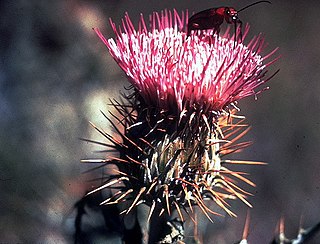
Chaenactis xantiana, the Mojave pincushion or Xantus pincushion, is a flowering plant in the family Asteraceae, native to the western United States, from southeastern Oregon, Nevada, southern and eastern California and northwestern Arizona. It is very common in the Antelope Valley in the Mojave Desert, and grows in sandy soils.

Chaenactis is a genus of plants in the daisy family which are known generally as pincushions or dustymaidens.

Chaenactis fremontii, with the common names Frémont's pincushion and desert pincushion, is a species of annual wildflower in the daisy family. Both the latter common name, and the specific epithet are chosen in honor of John C. Frémont.
Holozonia is a North American genus of flowering plants in the daisy family. It contains only one known species Holozonia filipes, which is known by the common name whitecrown. It is endemic to California.

Hulsea algida is a species of flowering plant in the daisy family, known by the common name Pacific hulsea or alpine gold.

Baileya pleniradiata is a North American species of flowering plant in the daisy family, known by the common name woolly desert marigold. It is native to desert regions of the southwestern United States and northern Mexico, where it grows in sandy habitats. It has been found in the States of Chihuahua, Sonora, Baja California, Arizona, Utah, and Nevada.
Brickellia arguta is a North American species of flowering plant in the daisy family known by the common name pungent brickellbush. It is native to the Mojave and Sonoran Deserts of California, Nevada, Arizona, and Baja California.
Calycadenia pauciflora is a species of flowering plant in the daisy family known by the common name smallflower western rosinweed. It is endemic to northern California, where it grows in the Coast Ranges north of the San Francisco Bay Area from Napa County to Tehama County.
Chaenactis alpigena is a species of flowering plant in the daisy family known by the common name southern Sierra pincushion. It is native to the High Sierra Nevada and the White Mountains of California, extending in the latter just into Nevada.

Chaenactis carphoclinia is a species of flowering plant in the daisy family known by the common name pebble pincushion. It is native to the southwestern United States and northwestern Mexico, where it grows in rocky and gravelly habitat, such as the California deserts. The species is found in southern California, Nevada, Utah, Arizona, southwestern New Mexico, Baja California, Sonora.

Chaenactis douglasii is a North American species of flowering plant in the daisy family known by the common name Douglas' dustymaiden.

Chaenactis glabriuscula, with the common name yellow pincushion, is a species of flowering plant in the daisy family. It is native to California and Baja California.

Chaenactis macrantha is a species of flowering plant in the daisy family known by the common names bighead dustymaiden and Mojave pincushion. It is native to the Great Basin and the southwestern deserts of the United States, in California, Arizona, Utah, Nevada, southwestern Idaho, and southeastern Oregon. It grows in dry, open habitat with gravelly, sandy soils, often calcareous or alkaline in nature.
Chaenactis santolinoides is a California species of flowering plant in the daisy family known by the common name Santolina pincushion.

Chaenactis stevioides, with the common names Esteve's pincushion and desert pincushion, is a species of flowering plant in the daisy family.

Cirsium ochrocentrum is a species of thistle known by the common name yellowspine thistle. It is native to the Great Plains of the Central United States and to the desert regions of the western United States and northern Mexico. Its range extends from eastern Oregon east to the Black Hills of South Dakota, south as far as the Mexican State of Durango.

Crepis acuminata is a North American species of flowering plant in the daisy family known by the common name tapertip hawksbeard. It is native to the western United States where it grows in many types of open habitat.

Chaenactis suffrutescens is a species of flowering plant in the aster family known by the common name Shasta chaenactis.
Eriophyllum ambiguum is a species of flowering plant in the aster family known by the common name beautiful woolly sunflower. It is native to the deserts and adjacent hills of southern and eastern California, northwestern Arizona, and southern Nevada.

Amauriopsis dissecta is a North American species of flowering plants in the daisy family known by the common names yellow ragweed and ragleaf bahia. It is native to the western United States as far north as the Black Hills of South Dakota and Wyoming, as well as in northern Mexico.













